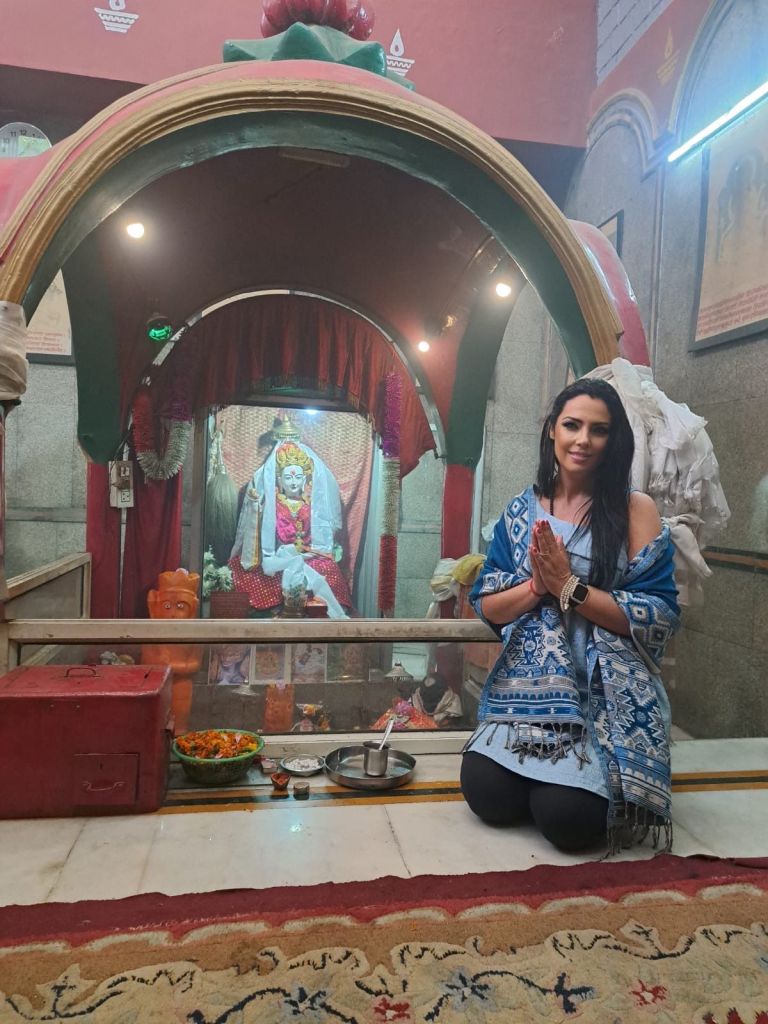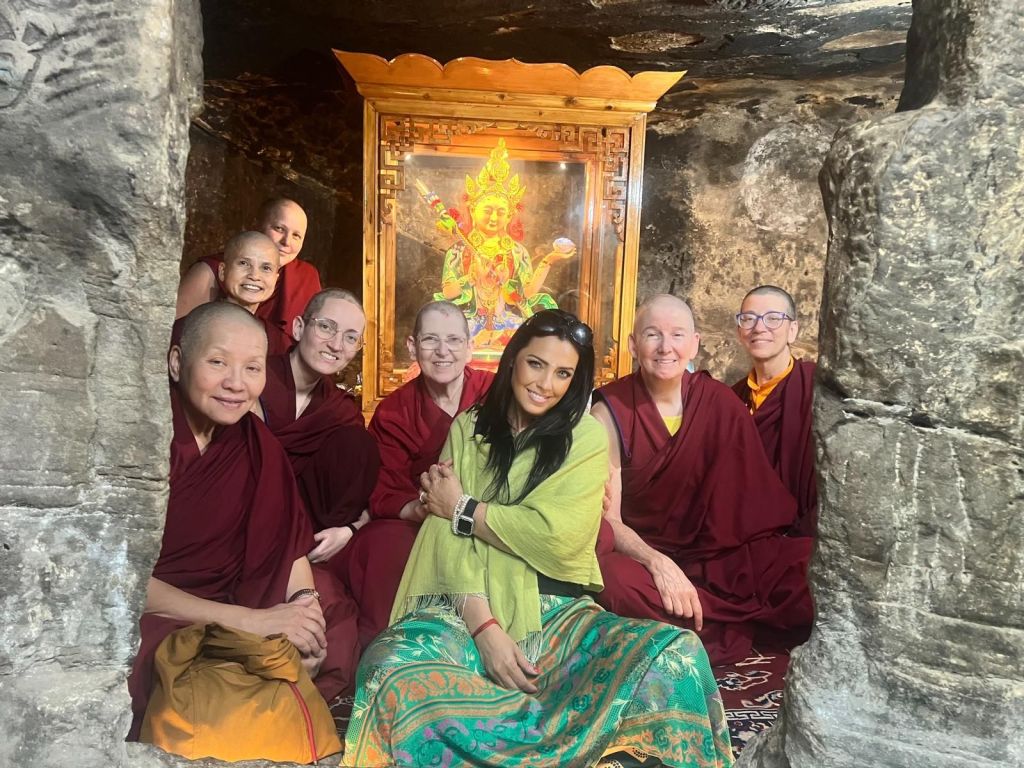
With a world struggling with post-pandemic recovery, the slow downturns of an economic recession, the ongoing disastrous wars in Europe, Israel and Gaza, with climate change, El Nino taking its full effect with Met Offices sending alarms to most states in India, as the heatwave looms early in a country going into elections in a months time, to decide the mandate of the largest democracy, the ground beneath our feet shaking with tremors in Taiwan, the volcanic ash billowing in sky in Iceland, the only way out it seems, is to look for insight wisdom, and, understanding as contrary to misinformation, distortion of meaning which has plagued our short-sighted individual, and, community life leaving no balance to restore peace, and, sobriety. This is exactly the mission that has inspired Sonia Gomes from Portugal to land in New Delhi, and, travel to Mandi in Himachal Pradesh, she, a student of Vajrayana Buddhism, a Yoga Teacher, with a doctoral degree in Marketing Management & Communications, and, a Masters Degree in Psychology, has been doing relentless work in helping women and children with practical solutions to face every situation or as she often says “learning to work with circumstances”, a lesson she attributes to the famous historical Princess of Zahor, the Indian consort of Padmasambhava (Guru Rinpoche), who in her life overcame all impediments, though being born a princess, she dedicated her life to emancipate women from the circular trap of samsara by using the powers of awareness only.



A place in the hilltop in Mandi, 2890 ft above sea level, which is Sonia Gomes’ destiny, the famous Mata Kuan Rani Temple, or, the ‘Princess of the Well Temple’, made of slate above a deep well, a certain meditative quietness prevails, enhanced by the natural elegance and rupture of the melodious blue-throated barbet, whistling thrush, near the banks of the river Beas, and, maybe, liturgical chants from the temple itself where the beautiful Princess Mandarava’s idol absorbs the prayers of the true aspirants of the Path, the North West Himalayan Rhododendron and Dog Violets, make the place a retreat of the highest awareness.
The implications of Sonia’s mission becomes even more magnified, if we understand the factual narrative of Princess Mandarava, who was born as a prodigious child, replete with spiritual powers of penance and austirity which bear close resemblances with Sakyamuni Buddha’s life, the semiotics of her parents’ dreams, the signs she confronted like sickness, old age and death that finally triggered her resignation of royal aristocratic life in exchange for seeking a path that would lead every being to becoming a Buddha, the awakened one. Another perspective that holds prominence in the Buddhist cannon, is Mandarava’s aspirations that symbolically resonate that with Tara, the goddess who becomes enlightened because she seeks the final liberation immersed in a sea of quietetude. Mandarava’s struggle is that of a woman, relevant even today, it bears the impression and markings of what a woman has to universlly undergo in familiar circumstances if she resolves to seek liberation for herself and for others. It is factually recorded that Princess Mandarava was enlightened the second time, in her past life she was Buddha Pandaravasini, an immortal awareness holder who carries the chalice of Nirvana into next birth only to use the opportunity to create a model for all aspirants, especially women seeking enlightenment. In her present avatar as Princess Mandarava, where we put our focus into, she ordained by the great Buddhist teacher Santaraksita, who also hailed from Mandi, meets Padmasambhava, the Lotus Born, also known as the second Buddha, undergoes rigorous training at Maratika cave in Nepal, post the Rewalsar lake event, and, finally achieves the great rainbow body or Vajrakaya (the three in one – nirmanakarya, sambhagokaya and dharmakaya), – these acts propels her immense dedication to practice as means to achieve the final goal of liberation. She, a student of Padmasambhava, also, a teacher in her own right, is the manifestation of grace (anugraha in Sanskrit) which is required for those who are sincere seekers of the Path. As the supreme “head of one hundred thousand dakinis” (dakinis are polysemous female figures, sometimes referred as goddess or a woman practitioner in esoteric tantric literature), Princess Mandarava, is the main consort of Padmasambhava, the India counterpart of Yeshe Tsogyal, and her role as wisdom dakini has true significance that enhances her nature as heroine who sought wisdom to liberate women.
Mandarava’s birth in Mandi, in Himachal Pradesh is just not a coincidence, after all the great sacred temples of Bhootnath, Trilokinath and others, dedicated to Lord Shiva, gave the place the status of being known as the Varanasi of the Hills or Chota Kashi, and, a true seeker who chooses like Buddha her parentage, must have been blessed by the Lord himself on her mission to enlightenment. Amidst the wildness of the butterfly bush, wild primula, and the barn swallow’s fading songs over a scarlet sunset in the clear skies of the Himalayan town, one would think that the morning and evening prayers are the only true source of sustenance in world of impermanence and the menacing chaos.



If someone is buying fruits and butter lamps, and, incense to be used for worship at the Mata Kuan Rani temple, then the Mandi market is where one must look for. In fact, the name mandi in Hindi translates to a marketplace, where the community meets to buy and sell, the ancient Sanskrit root word is “mandaptika”, an open hall or shed, it is not unusual if the aspirant is followed by a dog from the mandi market uphill to the temple, a sign of greater things to come, a gentle reminder of the famous oldest Zen Koan: Does a dog have a Buddha nature or not? In the silence of the distant mountains, the leaves among the trees whispered one ideograph- “Mu”, and, the prayers for liberation are set in the wheels of time.
– Joy Roy Choudhury, International Consultant, Media Outreach, and PR